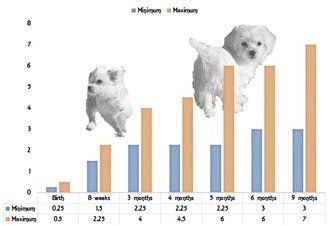Maltese Puppy Growth Chart
Overview
It's very common to want to know how big your Maltese puppy will be as he matures and what size he will be as an adult dog. With this breed, there is very little wiggle room; however, growth rates can vary quite a bit.
Here, we'll take cover the typical growth rate for Maltese puppies, look over a growth chart that shows expected minimum and maximum weights, and answer some common questions.
Expected Growth Rate
Newborn puppies should gain each day. For 8-week-old puppies that are just transitioning to their new homes, growth can be much more of a roller coaster.
Since this breed typically does not reach over 7 lbs. (though some pet Maltese do end up a bit larger than the standard, at 8 lbs. or so), the end goal is well within sight; however, the road to reach it will be unique for every puppy.
It is entirely possible for two 3-month-old Maltese puppies to be at different weights
(for example, 2.5 lbs. and 4 lbs.) but both end up as 6.5 lb. adults.
Nevertheless, when you take a look at the growth rate, you will see an upward movement that stretches from birth to the 9 month mark.
If a Maltese puppy is consistently on the low end of the scale, he will most likely end up being on the low end of the standard, which is 3 to 4 lbs. And if a Maltese puppy is consistently on the higher end of the growth scale, he is more than likely going to be on the higher end of the standard, at just under 7 lbs., and in some cases a bit larger.
Most of the growing will be done in the first 6 months. For the 3 remaining months of 6 to 9 months old, there may be small adjustments in weight, height, or both.
Elements That Can Affect Growth
There are some common factors that can affect how fast a puppy grows, as well as some less common but possible health conditions.
Common factors:
Nutrition.
The better a puppy's diet, the more fuel he has for his growing body. If a Maltese puppy is not growing as expected, this may be due to low-quality food than it is not offering enough nutrients. Fillers is a top problem, since these make a pup feel full without offering anything of value.
While most puppies do have hearty appetites, if a pup is not eating as much as he should, this can certainly affect his growth.
Health:
Any health conditions
may affect how fast a puppy grows, mostly due to decreased appetite. This includes a wide range of issues from infections to congenial diseases.
Maltese Puppy Growth Chart
Keeping in mind that the rate at which Maltese puppies grow can be staggeringly different depending on the pup, and puppies of all sizes can vary when young but reach the same adult weight, below is a chart to show the typical growth that is expected. All numbers are in pounds.
Chart:
Birth = .25 to .5 lbs., 8 weeks = 1.5 to 2.25 lbs., 3 months = 2.25 to 4 lbs., 4 months = 2.25 to 4.5 lbs., 5 months = 2.25 to 6 lbs., 6 months = 3 to 6 lbs., 9 months = 3 to 7 lbs.
Common Maltese Puppy Growth Questions
Q:
My Maltese puppy is already very big for her size, but her parents are just 4 and 6 pounds. Is it possible for my puppy to be larger than the parents?
A:
Yes. While seeing both sire and dam is a good indication of how big a Maltese puppy will be when he is fully grown, the genetics that determine a dog's size can be influenced from up to 5 generations back.
If a puppy is larger than both of his parents, chances are that a grandparent, great-grandparent or a relative even further back was a Maltese on the larger size.
Q:
I got my Maltese puppy from a breeder who promised me that he would be 6.25 pounds. He's already 5 pounds at only 4 months! What can I do?
A:
Reputable breeders know to never make promises to such an exacting degree in regard to the final adult size
of a puppy. While good breeding practices can certainly place most Maltese dogs into the standard range of 3 or 4 to just under 7 lbs. exact size down to 1/4 pounds is not something that can be completely guaranteed.
New puppy buyers should expect a 2 pound difference in either direction from the estimated adult size, excluding those expected to be 3 lbs. in which case this is usually the minimum.
As long as your Maltese is purebred, he will most likely not exceed 8 pounds, so you will indeed have a tiny toy sized dog, and it is not recommended to get caught up in the difference of a pound or two.
Q:
My 5 month old Maltese puppy seems to be experiencing discomfort, but I can't pinpoint it. Could this be growing pains?
A:
With puppies that have a phase of very rapid growth, this is possible. However, this is not applicable to most Maltese pups and is more often found with medium and large sized breeds.
If your puppy appears to be suffering from some sort of discomfort and symptoms do not ease up after a couple of days, are affecting his appetite, or his condition appears to worsen, you'll want to bring your Maltese to the veterinarian for a full examination.

There are a lot of parts that all come together for optimum comfort, health, safety, and happiness.
This is a great round-up of all the important elements of feeding, grooming, coat care, and more.

When a Maltese has trouble staying home alone, this is very stressful for owners and overwhelmingly difficult for the puppy or dog.
Fortunately, there are quite a few things that you can do to help a Maltese feel safe, comfortable, and even happy when he's by himself.
Spotlight Article
This involves removing possible triggers, daily maintenance, and using an effective stain remover

-min-450x169-480w.jpg)



-min-180x187-344w.jpg)

